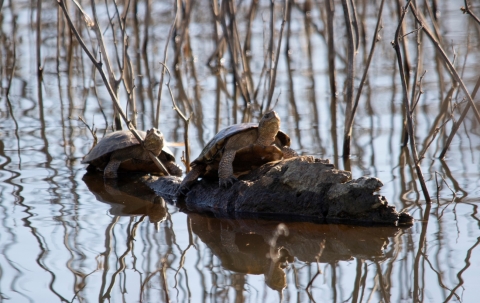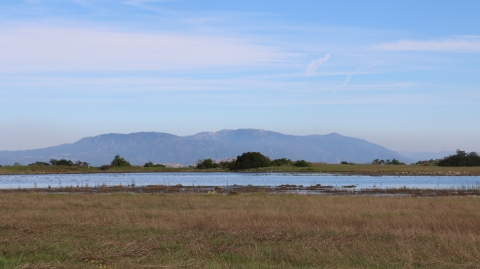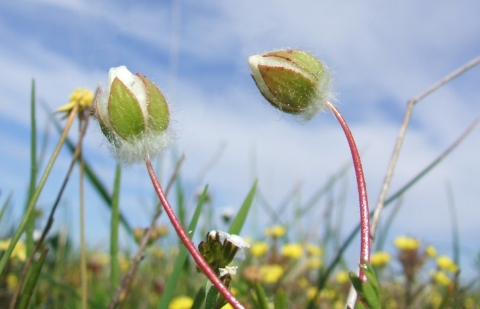The Department of the Interior today announced more than $40.6 million in grants through the U.S. Fish and Wildlife Service to 10 states and the U.S. Virgin Islands. Grants will support land acquisition and conservation planning projects on over 7,200 acres of habitat for 65 listed and at-risk species through the Cooperative Endangered Species Conservation Fund.
Of that 40.6 million, more than half will go towards preserving endangered species in San Diego County, Placer County, Riverside County and Butte County in California. The grants will support listed species like Stephens’ kangaroo rat, Quino checkerspot butterfly, the valley elderberry longhorn beetle, Otay tarplant, and at-risk wildlife such as the western spadefoot and western pond turtle.
Authorized by Section 6 of the Endangered Species Act and partly funded through the Land and Water Conservation Fund, the Cooperative Endangered Species Conservation Fund provides awards to states through two nationally competitive grant programs: the Recovery Land Acquisition Grant Program, which provides funds for the acquisition of habitat in support of Service-approved recovery plans, and the Habitat Conservation Plan Land Acquisition Grant Program, which provides funds to acquire habitat for listed and at-risk species to complement conservation strategies for approved Habitat Conservation Plans.
The Cooperative Endangered Species Conservation Fund contributes millions annually to support the implementation of state and territorial programs that conserve and recover federally listed and at-risk species on non-federal lands. This approach to conservation, done in cooperation with states, territories, willing landowners and local partners, furthers species conservation and facilitates compatible economic development. The grants will be matched by more than $17.6 million in partner funds.
Projects selected for funding in California:
Habitat Conservation Plan Land Acquisition Grants
Multiple Species Conservation Program (MSCP) County of San Diego Subarea Plan- Otay Ranch Village 14 and Planning Areas 16 and 19
San Diego County, CA - $2,500,000
This funding will be leveraged with other funding sources for the acquisition and permanent protection of 1,291 acres of highly vulnerable land that supports habitat for 24 species and augments regional conservation planning efforts in San Diego County. The property proposed for acquisition supports habitat for the federally threatened coastal California gnatcatcher, Otay tarplant, spreading navarretia, and the federally endangered Quino checkerspot butterfly, San Diego button celery, and San Diego fairy shrimp. The property is a significant biological core resource area identified within the San Diego MSCP due to its high concentration of sensitive biological resources, which if lost, could not be replaced, or mitigated elsewhere. The property connects the San Diego National Wildlife Refuge with California Department of Fish and Wildlife’s Rancho Jamul Ecological Reserve, making it an essential habitat linkage.
Western Riverside County Multiple Species Habitat Conservation Plan (MSHCP)
Riverside County, CA - $8,971,625
This funding award, along with State funding, will enable the acquisition and permanent protection of hundreds of acres of land that supports essential core and linkage habitat areas identified in the Western Riverside County MSHCP- specifically within the French Valley area of the City of Murrieta. The acquired properties will provide habitat for a suite of covered species including the federally endangered Riverside fairy shrimp, Quino checkerspot butterfly, least Bell’s vireo, and Munz’s onion, and federally threatened coastal California gnatcatcher, and Stephens’ kangaroo rat, and the at-risk western spadefoot toad and western pond turtle. The land proposed for acquisition is a key linkage between conserved habitat and complements the existing and future preserve areas within the Western Riverside County MSHCP.
Placer County Conservation Plan – Riosa Redwing Ranch North Acquisition
Placer County, CA - $4,286,413
This funding will support the acquisition and permanent protection, through a conservation easement conservation easement
A conservation easement is a voluntary legal agreement between a landowner and a government agency or qualified conservation organization that restricts the type and amount of development that may take place on a property in the future. Conservation easements aim to protect habitat for birds, fish and other wildlife by limiting residential, industrial or commercial development. Contracts may prohibit alteration of the natural topography, conversion of native grassland to cropland, drainage of wetland and establishment of game farms. Easement land remains in private ownership.
Learn more about conservation easement , of the northern 430 acres of the Riosa Redwing Ranch by the Placer Conservation Authority. The southern 560 acres of the Riosa Redwing Ranch was previously acquired using funds from the 2021 Section 6 grant cycle. This property contains important vernal pool habitat for the vernal pool fairy shrimp and vernal pool tadpole shrimp, as well as riparian riparian
Definition of riparian habitat or riparian areas.
Learn more about riparian habitat for the valley elderberry longhorn beetle along Yankee Slough. Conservation of the property will connect to a large block of existing protected lands, totaling approximately 1,700 acres, that will promote landscape connectivity. This acquisition will further the Conservation Strategy of the Placer County Conservation Plan, including protecting large blocks of connected lands within the Plan’s Reserve System and protecting species habitat, wetlands, and streams.
Recovery Land Acquisition Grants
Butte County Meadowfoam Three Parcel Land Acquisition
Butte County, CA - $7,000,000
The purpose is to promote the recovery of the federally endangered Butte County meadowfoam, through permanent protection of 174 acres of occupied habitat. These three properties include vernal pool complexes that are occupied by this species. The vernal pool habitat on these properties is suitable for the endangered vernal pool tadpole shrimp and occupied by the threatened the vernal pool fairy shrimp. Two of the properties will connect to a large block of existing protected lands, promoting landscape connectivity for wildlife in the area.
The Service also approved more than $3.9 million in grant awards to five states under the Conservation Planning Assistance Grant Program. Funding awarded through this program may be used to support the development, renewal or amendment of voluntary landowner agreements, i.e., HCPs, safe harbor agreements and candidate conservation agreements with assurances. Eligible activities include document preparation, public outreach, baseline species surveys, habitat assessments, inventories and environmental compliance. This year’s awards will support six conservation planning efforts covering 39 listed, candidate and at-risk species.
Today’s announcement comes as the Department honors the ESA’s 50th anniversary. Throughout the year, the Department is celebrating the ESA’s importance in preventing imperiled species extinction, promoting the recovery of wildlife and conserving the habitats upon which they depend. The ESA has been highly effective and credited with saving 99% of listed species from extinction. Thus far, more than 100 species of plants and animals have been delisted based on recovery or reclassified from endangered to threatened based on improved conservation status, and hundreds more species are stable or improving thanks to the collaborative actions of federal agencies; Tribal, state and local governments; conservation organizations and private citizens.
See the full list of awards here and learn more about the Cooperative Endangered Species Conservation Fund grant programs, please visit the Service’s program page.









